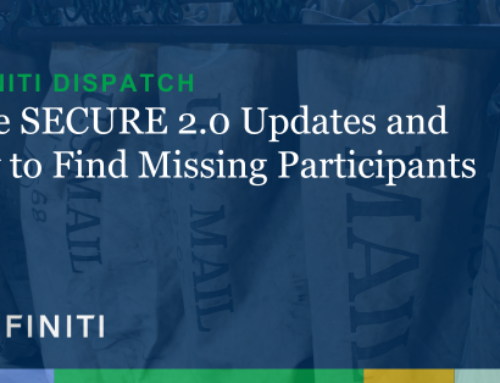VOL 10: Required Minimum Distributions
Proposed Regulations on Required Minimum Distributions
On February 23, 2022, the IRS released proposed regulations concerning required minimum distributions (RMDs), which provide the IRS’s interpretation of the Setting Every Community Up for Retirement Enhancement (SECURE) Act. Most provisions are anticipated to be incorporated into the final regulations and would apply to RMDs relating to 2022 and later calendar years.
RMDs Under the SECURE Act and Other Pending Legislation
The SECURE Act changed the age when nearly all qualified plan and Individual Retirement Account (IRA) participants will be required to take their first RMD. An RMD is generally required by April 1 of the year following the calendar year in which the participant attains age 72, an increase from age 70 ½ prior to the SECURE Act. This date is known as the Required Beginning Date (RBD).
As outlined in our last ERISA Connection, pending legislation may increase the age at which RMDs are triggered, gradually over 10 years to the following:
- Age 73 for participants who reach age 72 after December 31, 2022, and age 72 before January 1, 2030
- Age 74 for participants who reach age 73 after December 31, 2029, and age 74 before January 1, 2033
- Age 75 for participants who reach age 74 after December 31, 2032
Effective for distributions on or after January 1, 2020, there are three categories of beneficiaries: non-designated beneficiary (NDB), designated beneficiary and eligible designated beneficiary (EDB). These classifications determine post-death RMD periods. NDB is generically defined as a beneficiary who is not a designated beneficiary or EDB. Typically, NDB is an estate, charity or specific type of trust.
Designated beneficiaries are usually living individuals but can also be a see-through trust (see below for more detail). For designated beneficiaries, the participant’s account balance must be distributed under a 10-year rule.
Under the SECURE Act, the term “eligible designated beneficiary” was introduced, which is described as the spouse, a disabled or chronically ill beneficiary, and a beneficiary who is not more than 10 years younger than the participant. The proposed regulations further defined these. Eligible designated beneficiaries can continue to take distributions from the account over their life expectancies, subject to certain rules. Upon the death of the EDB, the 10-year rule applies to the successor beneficiary, meaning the account balance must be distributed by the end of the tenth calendar year following the year of the EDB’s death.
Proposed Rules – Participant Dies Before Required Beginning Date
If a participant with an EDB dies before they reach the RBD, payments can be made based on the EDB’s life expectancy or the 10-year rule, according to plan terms. If the EDB’s life expectancy applies, payments must start the year after the participant’s death, unless the EDB is the surviving spouse. In this case, the surviving spouse can delay the commencement of benefits until the year the participant would have reached their RBD. If the participant dies with a designated beneficiary (but not an EDB), the benefit must be paid within 10 years following the participant’s death.
The proposed rules clarify that if the 10-year rule applies, a full and complete distribution must be made by the end of the tenth calendar year after the calendar year of the participant’s death. Additionally, the rules clarify that distributions don’t have to start before this date, which is consistent with the five-year rule under current regulations.
Proposed Rules – Participant Dies After Required Beginning Date
If the participant dies after their RBD, Section 401(a)(9) requires distribution to the participant’s beneficiary be made at least as rapidly as the participant had been receiving them. The effect of this section is that under the 10-year rule that applies in the case of a designated beneficiary, the “at least as rapidly rule” continues to require the annual payment of RMDs during the 10-year post-death period, with a balloon payment of any remaining balance in year 10.
Important Note: This proposed rule impacts a designated beneficiary who inherited accounts from owners who passed away in 2020 and did not take an annual distribution during 2021, thinking they were not required to do so. Since these regulations are proposed, they are not a legal requirement until finalized and published. However, affected individuals would be prudent to revisit distributions and, at a minimum, begin taking distributions in 2022 while awaiting further guidance on how to treat RMDs not taken in 2021. Generally, penalties are applied if RMDs are not taken when required, but it is possible the IRS may grant a waiver of the penalties or a grace period once the regulations are finalized to allow affected individuals to take the missed distributions in the current year. However, this is not guaranteed.
If the beneficiary is an EDB, the benefit may be taken under the 10-year rule or over the life expectancy of the EDB. The current regulations give plans some freedom in applying the distribution rules to designated beneficiaries. The proposed regulations give plans similar latitude for EDBs, but not for designated beneficiaries.
- The plan can require payments to EDBs to follow the stretch rule or 10-year rule.
- The plan can let the participant or EDB choose which rule applies, but the plan must specify which rule applies if no election is made.
- If the plan is silent on which rule applies, payments to EDBs must follow the stretch rule.
- The plan needn’t apply the same rule to all participants’ EDBs.
Five-year Rule Applies to NDBs
The proposed regulations confirm that if a participant doesn’t have a designated beneficiary, the five-year rule continues to apply. Under the current and proposed regulations, only individuals can be designated beneficiaries, except for see-through trusts (see below for more detail)..
Trust Beneficiary Rules
The current regulations provide an exception for “see-through” trusts as designated beneficiaries, but they must satisfy the requirements of Treasury Regulation Section 1.401(a)(9)-4, Q&A-5. The proposed regulations maintain the concept of see-through trusts but include significantly more detail on determining if a trust’s beneficiaries are treated as beneficiaries of a participant’s interest in a plan. Arguably, the inclusion of these details is an attempt to minimize the need for a Private Letter Ruling on the status of the trust beneficiaries, which is a win-win.
Changes for Defined Benefit Plans
The rules for distributions to defined benefit beneficiaries are mostly unchanged, except that plans must include a default method for participants who make no election. If the plan is silent as to the distribution method, the beneficiary life expectancy rule applies if the participant has a designated beneficiary. If the participant doesn’t have a designated beneficiary, the five-year rule would apply.
We’re Here to Help
—
 CAROLYN CUMBEE, JD, LLM
CAROLYN CUMBEE, JD, LLM
ERISA Attorney | caroyln.cumbee@definiti-llc.com
Carolyn has more than 18 years of experience working with qualified plans as an ERISA attorney, assisting with the design, implementation and administration of tax-qualified retirement plans, including 401(k), defined benefit, cash balance and 403(b) plans. She frequently advises Definiti’s clients on best practices and methods for correcting many plan document and administrative failures.
This material has been prepared for informational purposes only, and is not intended to provide legal, tax or investment advice. Any tax-related discussion contained in this material is not intended or written to be used, and cannot be used, for (i) avoiding any tax penalties, or (ii) promoting, marketing or recommending to any other party any transaction or matter addressed herein. This material does not provide fiduciary recommendations concerning investments or investment management; it is not individualized to the needs of any specific benefit plan or retirement investor, nor is it directed to any recipient in connection with a specific investment or investment management decision. Please consult your independent legal counsel and/or professional tax advisor regarding any legal or tax issues raised in this material.
—





